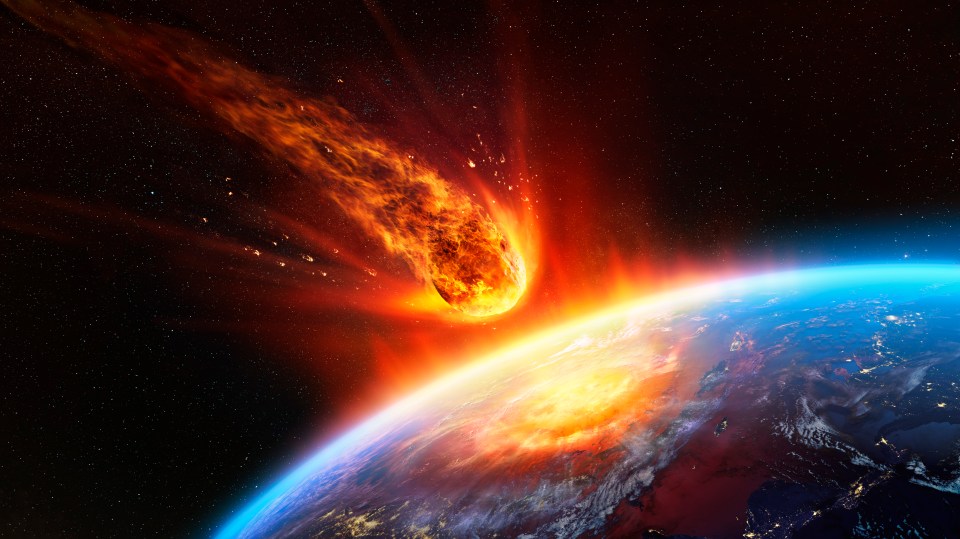SCIENTISTS do not have time to deflect the asteroid a size of a football pitch that is hurtling towards Earth, an expert has warned.
It comes as the odds of the Earth-threatening space rock dubbed 2024 YR4 colliding with our planet have shortened to a 1-in-43 chance.
GettyScientists may not have time to deflect asteroid 2024 YR4, one expert has claimed[/caption]
AFPAsteroid 2024 YR4 as observed by the Magdalena Ridge 2.4m telescope at the New Mexico Institute of Technology on January 27, 2025[/caption]
Scientists say the enormous rock is between 40 and 100 metres wide and would wipe out humanity if it hits.
The asteroid, named 2024 YR4, has been rated as the highest risk ever recorded by the European Space Agency (ESA).
Projections show its path could cross over with Earth’s orbit around Christmas time in 2032 – specifically 5:25 am on Wednesday, December 22.
With rising concerns about the chances of impact, researchers have suggested various deflection methods including solar lasers, nuclear bomba and kinetic impactors.
The latter is where scientists launch a spacecraft into an asteroid to knock it off its orbit.
This is the most likely available option but scientists have already run out of time, Dr Andrews claims.
He said on X: “I’ve often [been] told you need 10 years or more to build, plan and execute an asteroid deflection mission.
“Now let’s look at 2024 YR4. We have less than eight years to potentially deal with it, if needed.
“I’m not saying a kinetic impactor mission, or missions, couldn’t work.
“But we don’t have much time, and we don’t have enough info about this rapidly fading asteroid to properly inform our planetary defense decisions yet.”
Even if we did have time, he noted that the kinetic impactor method may not work.
In fact, he warned that the technique used two years ago in NASA‘s DART mission could be like “turning a cannonball into a shotgun spray,” increasing devastation on Earth.
He explained: “I’m seeing a lot of people claim that, if it is going to impact Earth in 2032, we can use a DART-like spacecraft to ram it out of the way.
“Well, not necessarily. The DART mission was fab, but might not be able to stop 2024 YR4.”
In 2022, Nasa’s DART spacecraft was deliberately driven into the side of Dimorphos – a small asteroid “moonlet”.
The mission was mainly to test Nasa’s planet defence systems, and was deemed a big success.
Speaking on the mission, Dr Andrews said: “As DART smashed into the asteroid, lots of debris flew back off the asteroid, acting like a rocket jet and giving it more of a push.”
But he warned that it does not prove the method can be used for all kinds of asteroid deflection.
He said: “Asteroids like Dimorphos, and smaller, tend to be rubble piles: not solid single rocks, but boulders weakly bound by their own gravity.
“Hitting them just right can produce that debris-like thrust effect, but if you hit them too hard, you’ll shatter them.
AFPNASA’s DART mission successfully used kinetic impactors to change the orbit of an asteroid[/caption]
“Nobody wants to accidentally ‘disrupt’ an asteroid, because those components can still head for Earth… it’s like turning a cannonball into a shotgun spray.”
Astronomer Dr David Whitehouse first noted the chances of a disastrous collision increasing as he said the asteroid is “unacceptable to ignore”.
The European Union-funded NEO Shield consortium which aims to investigate the best methods of stopping a clash presented some of its ideas including a nuclear bomb which would be a last resort.
An impact would unleash energy hundreds of times greater than that of the Hiroshima bomb with a blinding flash as shock waves that would flatten anything for miles.
One expert called it a potential ‘city-killer’ telling CBS that “if you put it over Paris or London or New York, you basically wipe out the whole city and some of the environs.”
A clever international team of astronomers have now been granted use of the iconic James Webb Space Telescope (JWST) so they can determine how much damage the asteroid may cause.
Astronomers are set to use the JWST in March to measure the exact size of 2024 YR4 and make any final calculations around its orbit.
The JWST, used by both the ESA and NASA, will take images of 2024 YR4 from its position a million miles away from Earth.
A second round of observations will also take place in May to determine how it has moved within a few months.
At the moment, scientists believe the asteroid could be up to 300ft wide – the same size as New York‘s Statue of Liberty or London‘s Big Ben.
NASA/Goddard/Arizona State UniversityThe asteroid could cause a crater the size of a city if it hits Earth[/caption]
Getty2024 YR4 is 27 million miles away but is set to reach us in December 2032 (stock)[/caption]

